Critical Reflection Journal: Education Module 1-4, Year 1
VerifiedAdded on 2023/06/03
|13
|4392
|370
Journal and Reflective Writing
AI Summary
This document is a critical reflection journal by a student, Sadaf Tauseef, focusing on various modules within an education program. The journal entries cover a range of topics including the definition of special education, goals for education, the concept of 'special needs,' and the importance of addressing the needs of both disabled and able students. Further entries discuss the assessment of disability, parental support for assessments, assistive technology, and inclusive practices for students requiring alternative curricula. The student reflects on forum posts, providing personal experiences and insights related to the course content, referencing key literature and discussing the practical implications of educational theories and practices. The journal provides a detailed overview of the student's learning journey and critical thinking throughout the course.
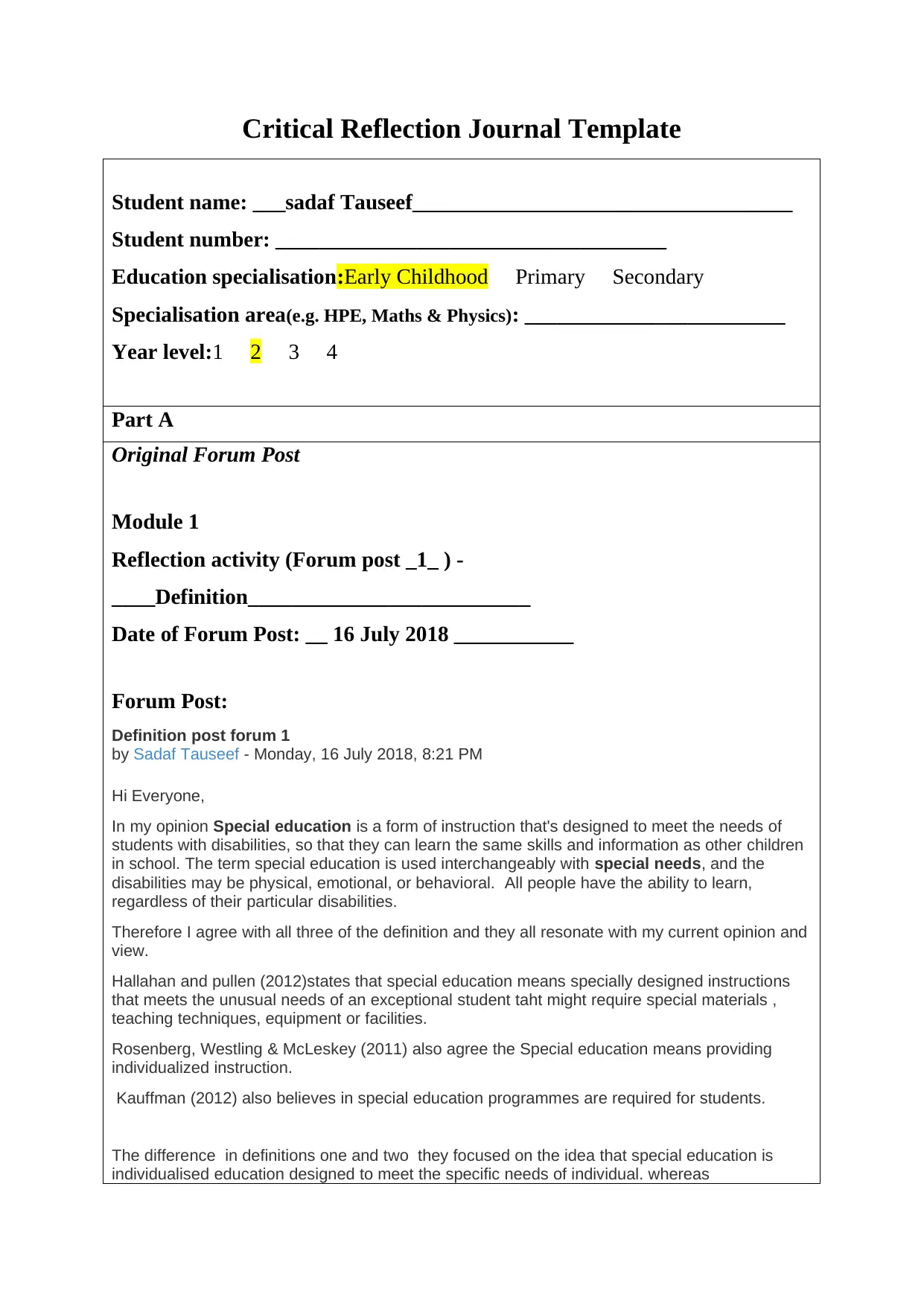
Critical Reflection Journal Template
Student name: ___sadaf Tauseef___________________________________
Student number: ____________________________________
Education specialisation:Early Childhood Primary Secondary
Specialisation area(e.g. HPE, Maths & Physics): ________________________
Year level:1 2 3 4
Part A
Original Forum Post
Module 1
Reflection activity (Forum post _1_ ) -
____Definition__________________________
Date of Forum Post: __ 16 July 2018 ___________
Forum Post:
Definition post forum 1
by Sadaf Tauseef - Monday, 16 July 2018, 8:21 PM
Hi Everyone,
In my opinion Special education is a form of instruction that's designed to meet the needs of
students with disabilities, so that they can learn the same skills and information as other children
in school. The term special education is used interchangeably with special needs, and the
disabilities may be physical, emotional, or behavioral. All people have the ability to learn,
regardless of their particular disabilities.
Therefore I agree with all three of the definition and they all resonate with my current opinion and
view.
Hallahan and pullen (2012)states that special education means specially designed instructions
that meets the unusual needs of an exceptional student taht might require special materials ,
teaching techniques, equipment or facilities.
Rosenberg, Westling & McLeskey (2011) also agree the Special education means providing
individualized instruction.
Kauffman (2012) also believes in special education programmes are required for students.
The difference in definitions one and two they focused on the idea that special education is
individualised education designed to meet the specific needs of individual. whereas
Student name: ___sadaf Tauseef___________________________________
Student number: ____________________________________
Education specialisation:Early Childhood Primary Secondary
Specialisation area(e.g. HPE, Maths & Physics): ________________________
Year level:1 2 3 4
Part A
Original Forum Post
Module 1
Reflection activity (Forum post _1_ ) -
____Definition__________________________
Date of Forum Post: __ 16 July 2018 ___________
Forum Post:
Definition post forum 1
by Sadaf Tauseef - Monday, 16 July 2018, 8:21 PM
Hi Everyone,
In my opinion Special education is a form of instruction that's designed to meet the needs of
students with disabilities, so that they can learn the same skills and information as other children
in school. The term special education is used interchangeably with special needs, and the
disabilities may be physical, emotional, or behavioral. All people have the ability to learn,
regardless of their particular disabilities.
Therefore I agree with all three of the definition and they all resonate with my current opinion and
view.
Hallahan and pullen (2012)states that special education means specially designed instructions
that meets the unusual needs of an exceptional student taht might require special materials ,
teaching techniques, equipment or facilities.
Rosenberg, Westling & McLeskey (2011) also agree the Special education means providing
individualized instruction.
Kauffman (2012) also believes in special education programmes are required for students.
The difference in definitions one and two they focused on the idea that special education is
individualised education designed to meet the specific needs of individual. whereas
Paraphrase This Document
Need a fresh take? Get an instant paraphrase of this document with our AI Paraphraser
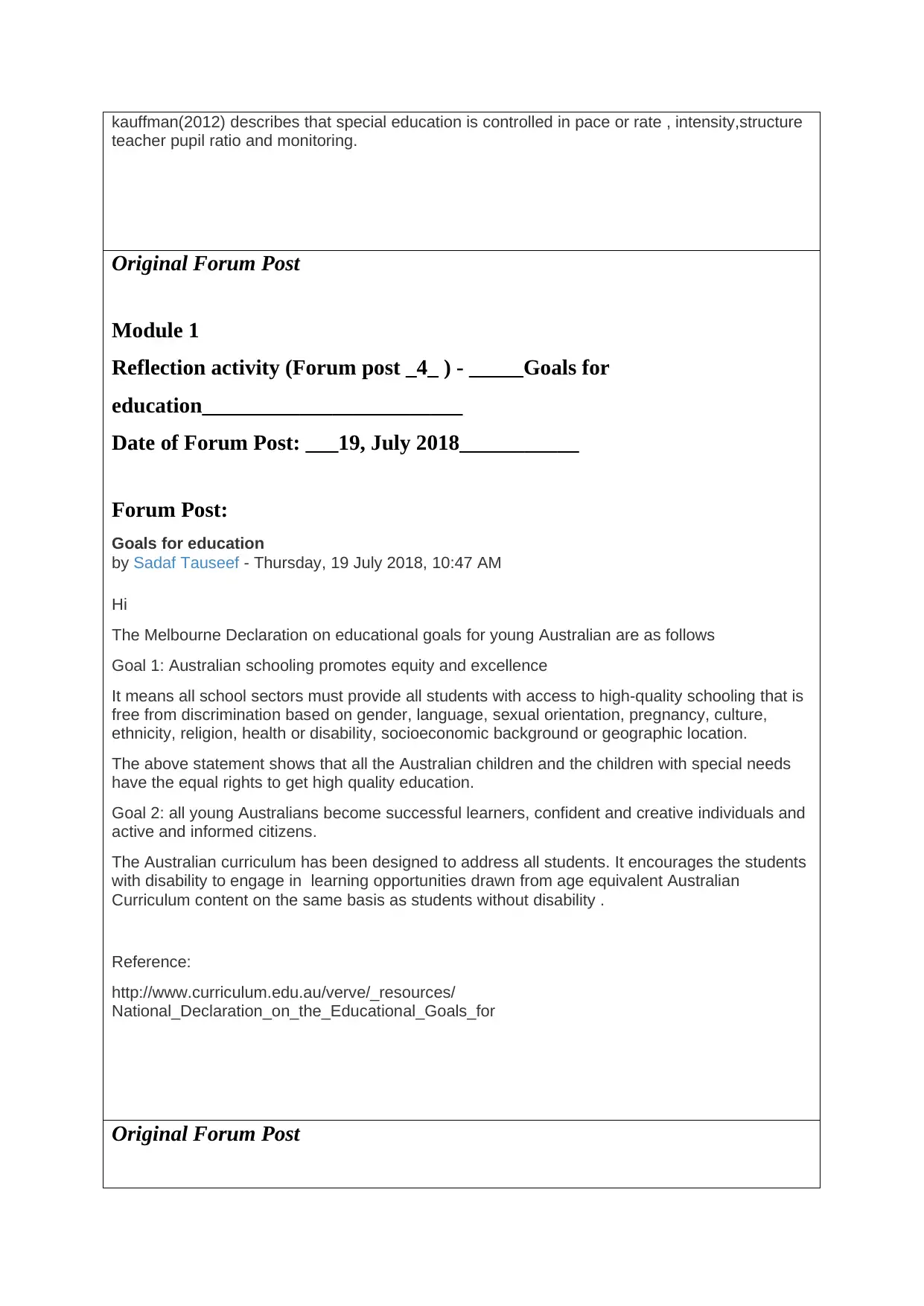
kauffman(2012) describes that special education is controlled in pace or rate , intensity,structure
teacher pupil ratio and monitoring.
Original Forum Post
Module 1
Reflection activity (Forum post _4_ ) - _____Goals for
education________________________
Date of Forum Post: ___19, July 2018___________
Forum Post:
Goals for education
by Sadaf Tauseef - Thursday, 19 July 2018, 10:47 AM
Hi
The Melbourne Declaration on educational goals for young Australian are as follows
Goal 1: Australian schooling promotes equity and excellence
It means all school sectors must provide all students with access to high-quality schooling that is
free from discrimination based on gender, language, sexual orientation, pregnancy, culture,
ethnicity, religion, health or disability, socioeconomic background or geographic location.
The above statement shows that all the Australian children and the children with special needs
have the equal rights to get high quality education.
Goal 2: all young Australians become successful learners, confident and creative individuals and
active and informed citizens.
The Australian curriculum has been designed to address all students. It encourages the students
with disability to engage in learning opportunities drawn from age equivalent Australian
Curriculum content on the same basis as students without disability .
Reference:
http://www.curriculum.edu.au/verve/_resources/
National_Declaration_on_the_Educational_Goals_for
Original Forum Post
teacher pupil ratio and monitoring.
Original Forum Post
Module 1
Reflection activity (Forum post _4_ ) - _____Goals for
education________________________
Date of Forum Post: ___19, July 2018___________
Forum Post:
Goals for education
by Sadaf Tauseef - Thursday, 19 July 2018, 10:47 AM
Hi
The Melbourne Declaration on educational goals for young Australian are as follows
Goal 1: Australian schooling promotes equity and excellence
It means all school sectors must provide all students with access to high-quality schooling that is
free from discrimination based on gender, language, sexual orientation, pregnancy, culture,
ethnicity, religion, health or disability, socioeconomic background or geographic location.
The above statement shows that all the Australian children and the children with special needs
have the equal rights to get high quality education.
Goal 2: all young Australians become successful learners, confident and creative individuals and
active and informed citizens.
The Australian curriculum has been designed to address all students. It encourages the students
with disability to engage in learning opportunities drawn from age equivalent Australian
Curriculum content on the same basis as students without disability .
Reference:
http://www.curriculum.edu.au/verve/_resources/
National_Declaration_on_the_Educational_Goals_for
Original Forum Post

Module 2
Reflection activity (Forum post __3) - ____Special needs really?
__________________________
Date of Forum Post: __29.7.2018____________
Forum Post:
special needs, Really? forum 3
by Sadaf Tauseef - Sunday, 29 July 2018, 6:24 PM
The idea of this short clip is that people with an intellectual disability should not feel less than
others and they should not be considered different or special. This video has awoken empathy
within myself and I agree with the little girl's plea about the fact that they should not feel special
and they should be treated like normal citizen of our society . They can develop skills which can
help them to participate in daily living.
According to the message in the clip about special needs these are defined are the needs of job,
opportunities, education and love from friends and family. These lifestyles are possible as a
result of improved developmental programs and community support.
Original Forum Post
Module 2
Reflection activity (Forum post __11) - _____________Gifts and
talents_________________
Date of Forum Post: ___Saturday, 18 August 2018___________
Forum Post:
Hi
Statement 1 portrays the fact that how the disabled children get more attention, but no or less
attention is given to the able ones. It is saddening since, at this tender age where students lack
understanding, it can affect them mentally. Yes, I agree with this statement. In my opinion,
disabled children do need particular attention, but in the process, the able students should not be
left behind. The teachers must concentrate on all the students and their respective needs.
Statement 2 talks about the fact the teachers must also look after the problems of toppers and
not only focus on the weak ones. I completely agree that more light is shed on students who
perform weakly in their studies which has a profound impact on the better performers in the
class. As a consequence, they might suffer from depression and anxiety seldom leading to poor
results.
Reflection activity (Forum post __3) - ____Special needs really?
__________________________
Date of Forum Post: __29.7.2018____________
Forum Post:
special needs, Really? forum 3
by Sadaf Tauseef - Sunday, 29 July 2018, 6:24 PM
The idea of this short clip is that people with an intellectual disability should not feel less than
others and they should not be considered different or special. This video has awoken empathy
within myself and I agree with the little girl's plea about the fact that they should not feel special
and they should be treated like normal citizen of our society . They can develop skills which can
help them to participate in daily living.
According to the message in the clip about special needs these are defined are the needs of job,
opportunities, education and love from friends and family. These lifestyles are possible as a
result of improved developmental programs and community support.
Original Forum Post
Module 2
Reflection activity (Forum post __11) - _____________Gifts and
talents_________________
Date of Forum Post: ___Saturday, 18 August 2018___________
Forum Post:
Hi
Statement 1 portrays the fact that how the disabled children get more attention, but no or less
attention is given to the able ones. It is saddening since, at this tender age where students lack
understanding, it can affect them mentally. Yes, I agree with this statement. In my opinion,
disabled children do need particular attention, but in the process, the able students should not be
left behind. The teachers must concentrate on all the students and their respective needs.
Statement 2 talks about the fact the teachers must also look after the problems of toppers and
not only focus on the weak ones. I completely agree that more light is shed on students who
perform weakly in their studies which has a profound impact on the better performers in the
class. As a consequence, they might suffer from depression and anxiety seldom leading to poor
results.
⊘ This is a preview!⊘
Do you want full access?
Subscribe today to unlock all pages.

Trusted by 1+ million students worldwide
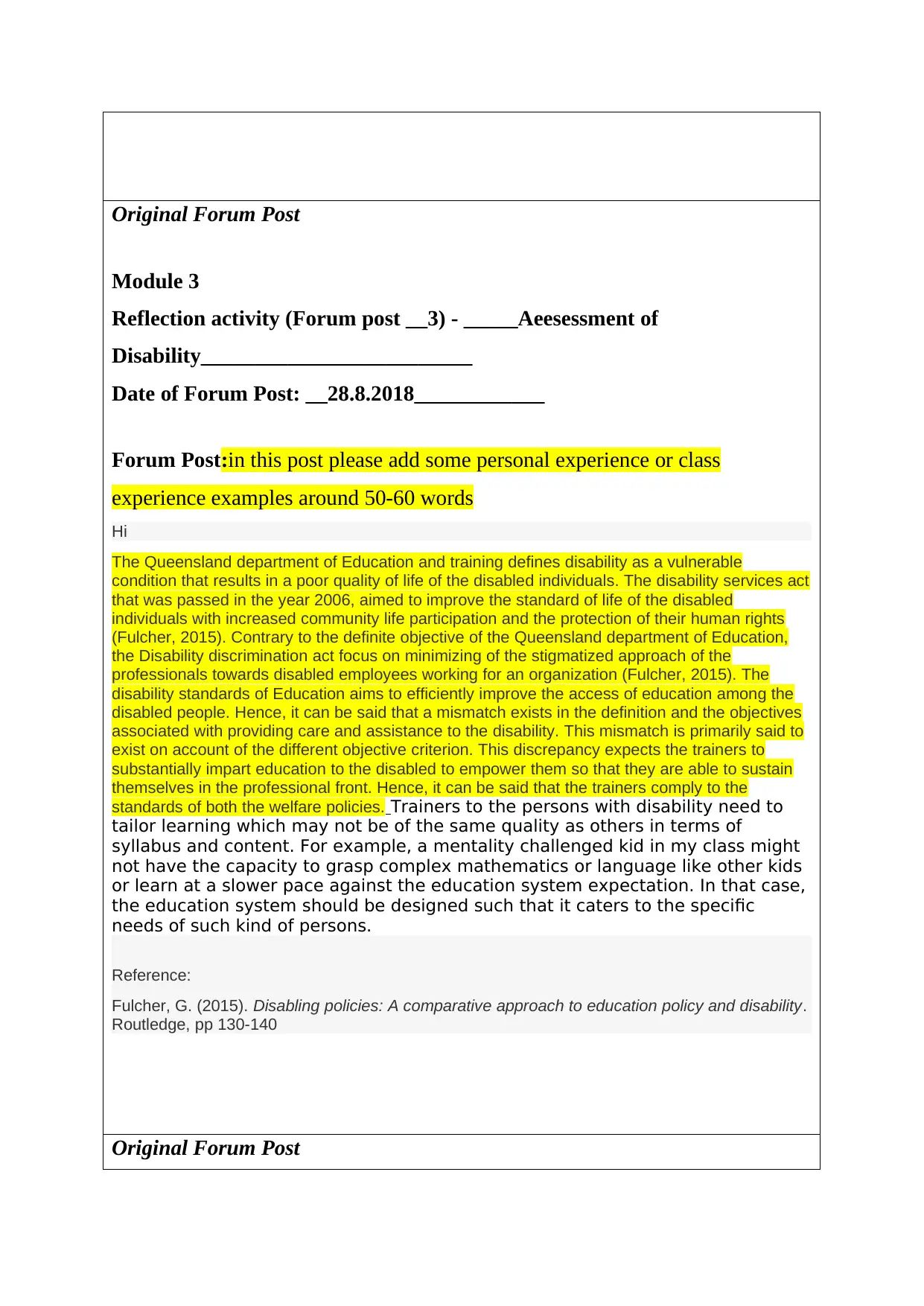
Original Forum Post
Module 3
Reflection activity (Forum post __3) - _____Aeesessment of
Disability_________________________
Date of Forum Post: __28.8.2018____________
Forum Post:in this post please add some personal experience or class
experience examples around 50-60 words
Hi
The Queensland department of Education and training defines disability as a vulnerable
condition that results in a poor quality of life of the disabled individuals. The disability services act
that was passed in the year 2006, aimed to improve the standard of life of the disabled
individuals with increased community life participation and the protection of their human rights
(Fulcher, 2015). Contrary to the definite objective of the Queensland department of Education,
the Disability discrimination act focus on minimizing of the stigmatized approach of the
professionals towards disabled employees working for an organization (Fulcher, 2015). The
disability standards of Education aims to efficiently improve the access of education among the
disabled people. Hence, it can be said that a mismatch exists in the definition and the objectives
associated with providing care and assistance to the disability. This mismatch is primarily said to
exist on account of the different objective criterion. This discrepancy expects the trainers to
substantially impart education to the disabled to empower them so that they are able to sustain
themselves in the professional front. Hence, it can be said that the trainers comply to the
standards of both the welfare policies. Trainers to the persons with disability need to
tailor learning which may not be of the same quality as others in terms of
syllabus and content. For example, a mentality challenged kid in my class might
not have the capacity to grasp complex mathematics or language like other kids
or learn at a slower pace against the education system expectation. In that case,
the education system should be designed such that it caters to the specific
needs of such kind of persons.
Reference:
Fulcher, G. (2015). Disabling policies: A comparative approach to education policy and disability.
Routledge, pp 130-140
Original Forum Post
Module 3
Reflection activity (Forum post __3) - _____Aeesessment of
Disability_________________________
Date of Forum Post: __28.8.2018____________
Forum Post:in this post please add some personal experience or class
experience examples around 50-60 words
Hi
The Queensland department of Education and training defines disability as a vulnerable
condition that results in a poor quality of life of the disabled individuals. The disability services act
that was passed in the year 2006, aimed to improve the standard of life of the disabled
individuals with increased community life participation and the protection of their human rights
(Fulcher, 2015). Contrary to the definite objective of the Queensland department of Education,
the Disability discrimination act focus on minimizing of the stigmatized approach of the
professionals towards disabled employees working for an organization (Fulcher, 2015). The
disability standards of Education aims to efficiently improve the access of education among the
disabled people. Hence, it can be said that a mismatch exists in the definition and the objectives
associated with providing care and assistance to the disability. This mismatch is primarily said to
exist on account of the different objective criterion. This discrepancy expects the trainers to
substantially impart education to the disabled to empower them so that they are able to sustain
themselves in the professional front. Hence, it can be said that the trainers comply to the
standards of both the welfare policies. Trainers to the persons with disability need to
tailor learning which may not be of the same quality as others in terms of
syllabus and content. For example, a mentality challenged kid in my class might
not have the capacity to grasp complex mathematics or language like other kids
or learn at a slower pace against the education system expectation. In that case,
the education system should be designed such that it caters to the specific
needs of such kind of persons.
Reference:
Fulcher, G. (2015). Disabling policies: A comparative approach to education policy and disability.
Routledge, pp 130-140
Original Forum Post
Paraphrase This Document
Need a fresh take? Get an instant paraphrase of this document with our AI Paraphraser
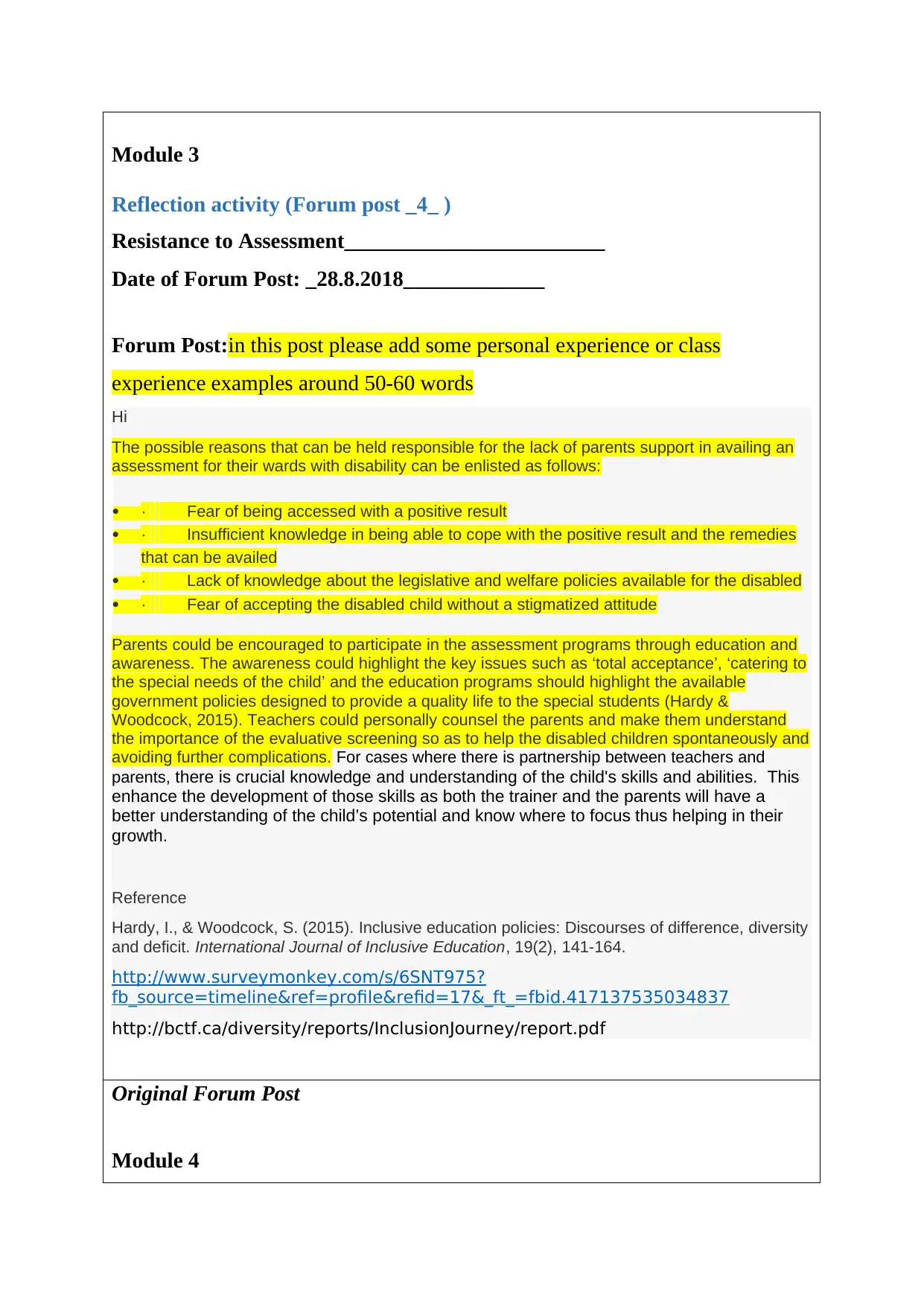
Module 3
Reflection activity (Forum post _4_ )
Resistance to Assessment________________________
Date of Forum Post: _28.8.2018_____________
Forum Post:in this post please add some personal experience or class
experience examples around 50-60 words
Hi
The possible reasons that can be held responsible for the lack of parents support in availing an
assessment for their wards with disability can be enlisted as follows:
· Fear of being accessed with a positive result
· Insufficient knowledge in being able to cope with the positive result and the remedies
that can be availed
· Lack of knowledge about the legislative and welfare policies available for the disabled
· Fear of accepting the disabled child without a stigmatized attitude
Parents could be encouraged to participate in the assessment programs through education and
awareness. The awareness could highlight the key issues such as ‘total acceptance’, ‘catering to
the special needs of the child’ and the education programs should highlight the available
government policies designed to provide a quality life to the special students (Hardy &
Woodcock, 2015). Teachers could personally counsel the parents and make them understand
the importance of the evaluative screening so as to help the disabled children spontaneously and
avoiding further complications. For cases where there is partnership between teachers and
parents, there is crucial knowledge and understanding of the child's skills and abilities. This
enhance the development of those skills as both the trainer and the parents will have a
better understanding of the child’s potential and know where to focus thus helping in their
growth.
Reference
Hardy, I., & Woodcock, S. (2015). Inclusive education policies: Discourses of difference, diversity
and deficit. International Journal of Inclusive Education, 19(2), 141-164.
http://www.surveymonkey.com/s/6SNT975?
fb_source=timeline&ref=profile&refid=17&_ft_=fbid.417137535034837
http://bctf.ca/diversity/reports/InclusionJourney/report.pdf
Original Forum Post
Module 4
Reflection activity (Forum post _4_ )
Resistance to Assessment________________________
Date of Forum Post: _28.8.2018_____________
Forum Post:in this post please add some personal experience or class
experience examples around 50-60 words
Hi
The possible reasons that can be held responsible for the lack of parents support in availing an
assessment for their wards with disability can be enlisted as follows:
· Fear of being accessed with a positive result
· Insufficient knowledge in being able to cope with the positive result and the remedies
that can be availed
· Lack of knowledge about the legislative and welfare policies available for the disabled
· Fear of accepting the disabled child without a stigmatized attitude
Parents could be encouraged to participate in the assessment programs through education and
awareness. The awareness could highlight the key issues such as ‘total acceptance’, ‘catering to
the special needs of the child’ and the education programs should highlight the available
government policies designed to provide a quality life to the special students (Hardy &
Woodcock, 2015). Teachers could personally counsel the parents and make them understand
the importance of the evaluative screening so as to help the disabled children spontaneously and
avoiding further complications. For cases where there is partnership between teachers and
parents, there is crucial knowledge and understanding of the child's skills and abilities. This
enhance the development of those skills as both the trainer and the parents will have a
better understanding of the child’s potential and know where to focus thus helping in their
growth.
Reference
Hardy, I., & Woodcock, S. (2015). Inclusive education policies: Discourses of difference, diversity
and deficit. International Journal of Inclusive Education, 19(2), 141-164.
http://www.surveymonkey.com/s/6SNT975?
fb_source=timeline&ref=profile&refid=17&_ft_=fbid.417137535034837
http://bctf.ca/diversity/reports/InclusionJourney/report.pdf
Original Forum Post
Module 4
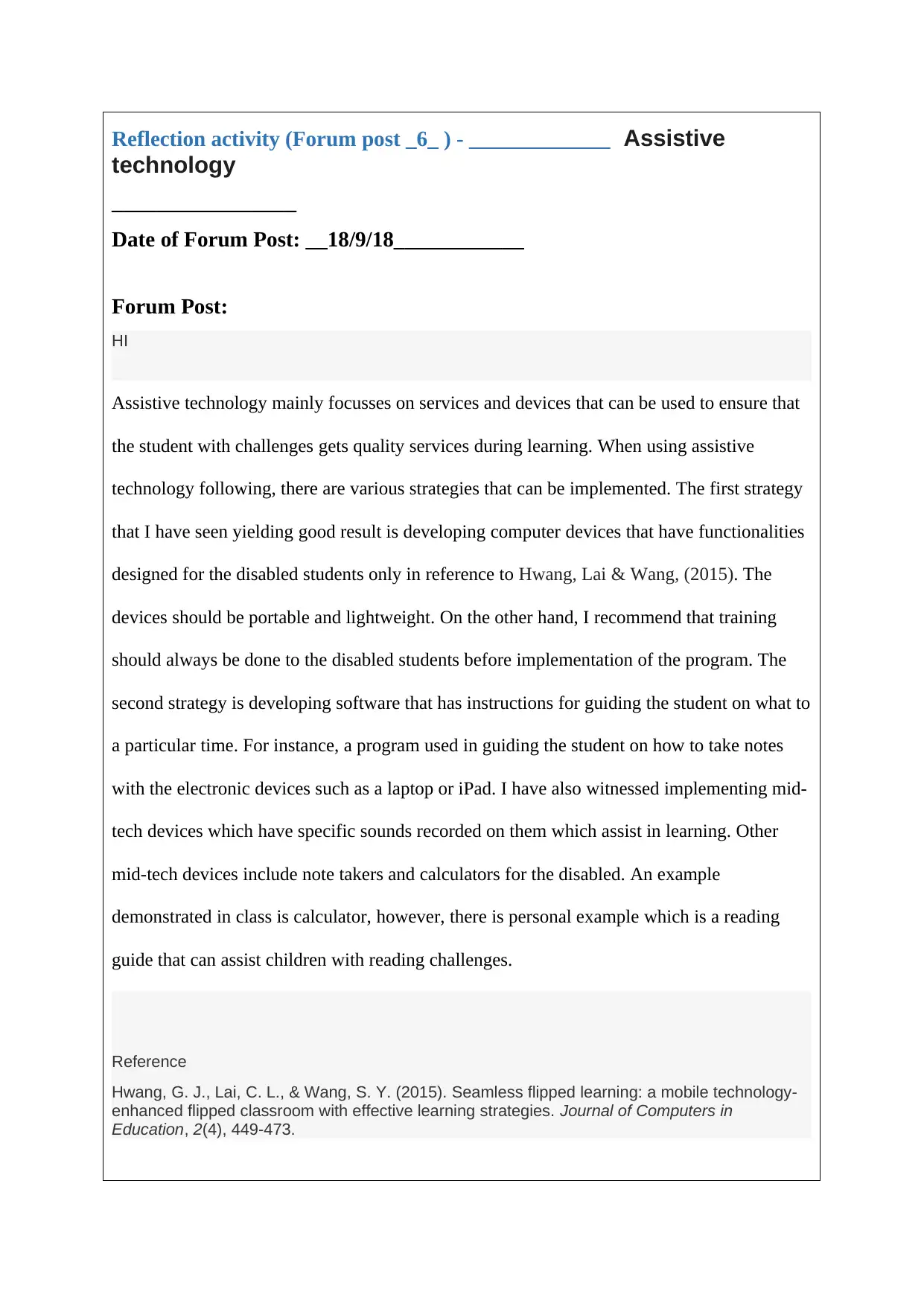
Reflection activity (Forum post _6_ ) - _____________ Assistive
technology
_________________
Date of Forum Post: __18/9/18____________
Forum Post:
HI
Assistive technology mainly focusses on services and devices that can be used to ensure that
the student with challenges gets quality services during learning. When using assistive
technology following, there are various strategies that can be implemented. The first strategy
that I have seen yielding good result is developing computer devices that have functionalities
designed for the disabled students only in reference to Hwang, Lai & Wang, (2015). The
devices should be portable and lightweight. On the other hand, I recommend that training
should always be done to the disabled students before implementation of the program. The
second strategy is developing software that has instructions for guiding the student on what to
a particular time. For instance, a program used in guiding the student on how to take notes
with the electronic devices such as a laptop or iPad. I have also witnessed implementing mid-
tech devices which have specific sounds recorded on them which assist in learning. Other
mid-tech devices include note takers and calculators for the disabled. An example
demonstrated in class is calculator, however, there is personal example which is a reading
guide that can assist children with reading challenges.
Reference
Hwang, G. J., Lai, C. L., & Wang, S. Y. (2015). Seamless flipped learning: a mobile technology-
enhanced flipped classroom with effective learning strategies. Journal of Computers in
Education, 2(4), 449-473.
technology
_________________
Date of Forum Post: __18/9/18____________
Forum Post:
HI
Assistive technology mainly focusses on services and devices that can be used to ensure that
the student with challenges gets quality services during learning. When using assistive
technology following, there are various strategies that can be implemented. The first strategy
that I have seen yielding good result is developing computer devices that have functionalities
designed for the disabled students only in reference to Hwang, Lai & Wang, (2015). The
devices should be portable and lightweight. On the other hand, I recommend that training
should always be done to the disabled students before implementation of the program. The
second strategy is developing software that has instructions for guiding the student on what to
a particular time. For instance, a program used in guiding the student on how to take notes
with the electronic devices such as a laptop or iPad. I have also witnessed implementing mid-
tech devices which have specific sounds recorded on them which assist in learning. Other
mid-tech devices include note takers and calculators for the disabled. An example
demonstrated in class is calculator, however, there is personal example which is a reading
guide that can assist children with reading challenges.
Reference
Hwang, G. J., Lai, C. L., & Wang, S. Y. (2015). Seamless flipped learning: a mobile technology-
enhanced flipped classroom with effective learning strategies. Journal of Computers in
Education, 2(4), 449-473.
⊘ This is a preview!⊘
Do you want full access?
Subscribe today to unlock all pages.

Trusted by 1+ million students worldwide
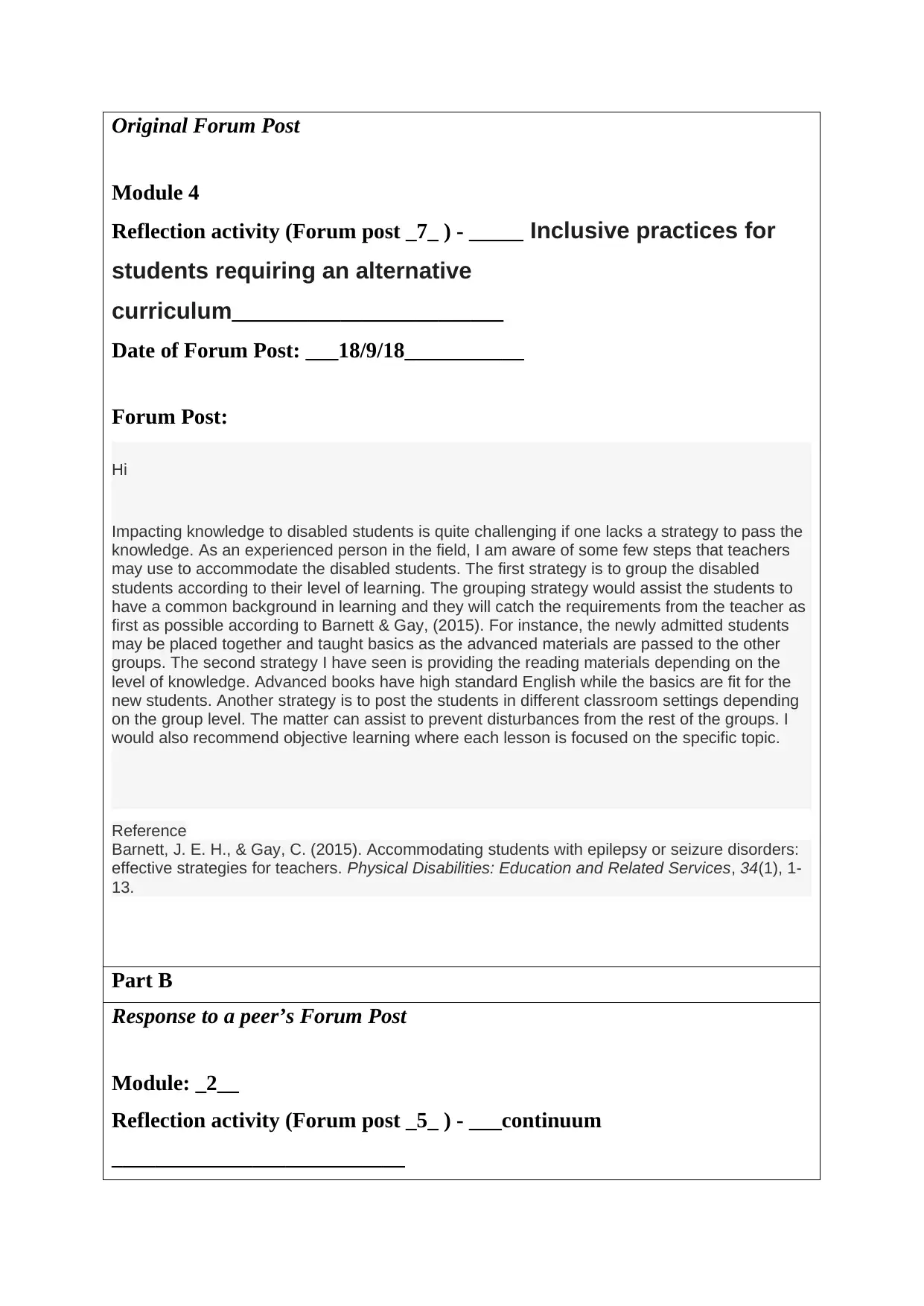
Original Forum Post
Module 4
Reflection activity (Forum post _7_ ) - _____ Inclusive practices for
students requiring an alternative
curriculum_________________________
Date of Forum Post: ___18/9/18___________
Forum Post:
Hi
Impacting knowledge to disabled students is quite challenging if one lacks a strategy to pass the
knowledge. As an experienced person in the field, I am aware of some few steps that teachers
may use to accommodate the disabled students. The first strategy is to group the disabled
students according to their level of learning. The grouping strategy would assist the students to
have a common background in learning and they will catch the requirements from the teacher as
first as possible according to Barnett & Gay, (2015). For instance, the newly admitted students
may be placed together and taught basics as the advanced materials are passed to the other
groups. The second strategy I have seen is providing the reading materials depending on the
level of knowledge. Advanced books have high standard English while the basics are fit for the
new students. Another strategy is to post the students in different classroom settings depending
on the group level. The matter can assist to prevent disturbances from the rest of the groups. I
would also recommend objective learning where each lesson is focused on the specific topic.
Reference
Barnett, J. E. H., & Gay, C. (2015). Accommodating students with epilepsy or seizure disorders:
effective strategies for teachers. Physical Disabilities: Education and Related Services, 34(1), 1-
13.
Part B
Response to a peer’s Forum Post
Module: _2__
Reflection activity (Forum post _5_ ) - ___continuum
___________________________
Module 4
Reflection activity (Forum post _7_ ) - _____ Inclusive practices for
students requiring an alternative
curriculum_________________________
Date of Forum Post: ___18/9/18___________
Forum Post:
Hi
Impacting knowledge to disabled students is quite challenging if one lacks a strategy to pass the
knowledge. As an experienced person in the field, I am aware of some few steps that teachers
may use to accommodate the disabled students. The first strategy is to group the disabled
students according to their level of learning. The grouping strategy would assist the students to
have a common background in learning and they will catch the requirements from the teacher as
first as possible according to Barnett & Gay, (2015). For instance, the newly admitted students
may be placed together and taught basics as the advanced materials are passed to the other
groups. The second strategy I have seen is providing the reading materials depending on the
level of knowledge. Advanced books have high standard English while the basics are fit for the
new students. Another strategy is to post the students in different classroom settings depending
on the group level. The matter can assist to prevent disturbances from the rest of the groups. I
would also recommend objective learning where each lesson is focused on the specific topic.
Reference
Barnett, J. E. H., & Gay, C. (2015). Accommodating students with epilepsy or seizure disorders:
effective strategies for teachers. Physical Disabilities: Education and Related Services, 34(1), 1-
13.
Part B
Response to a peer’s Forum Post
Module: _2__
Reflection activity (Forum post _5_ ) - ___continuum
___________________________
Paraphrase This Document
Need a fresh take? Get an instant paraphrase of this document with our AI Paraphraser
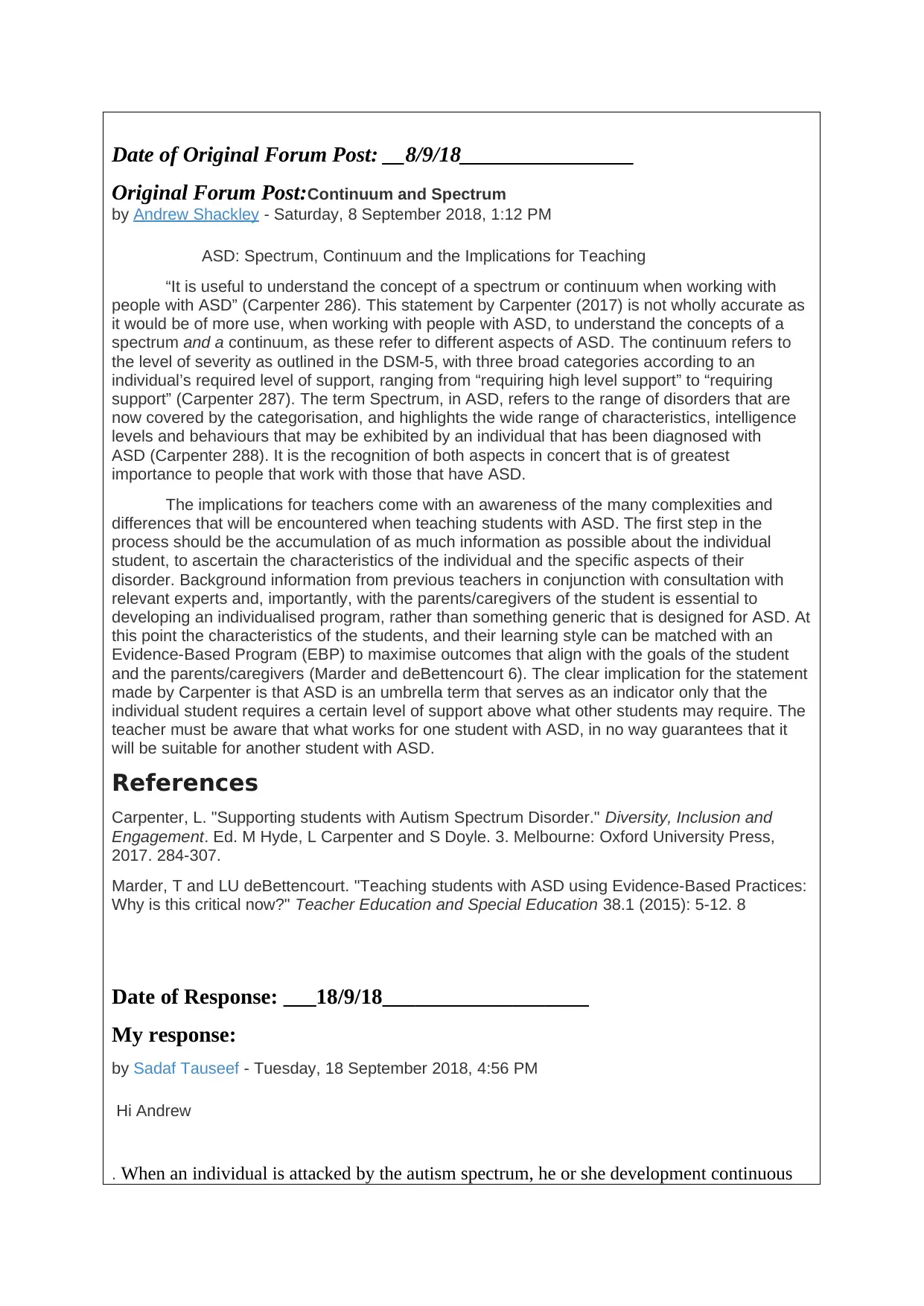
Date of Original Forum Post: __8/9/18________________
Original Forum Post:Continuum and Spectrum
by Andrew Shackley - Saturday, 8 September 2018, 1:12 PM
ASD: Spectrum, Continuum and the Implications for Teaching
“It is useful to understand the concept of a spectrum or continuum when working with
people with ASD” (Carpenter 286). This statement by Carpenter (2017) is not wholly accurate as
it would be of more use, when working with people with ASD, to understand the concepts of a
spectrum and a continuum, as these refer to different aspects of ASD. The continuum refers to
the level of severity as outlined in the DSM-5, with three broad categories according to an
individual’s required level of support, ranging from “requiring high level support” to “requiring
support” (Carpenter 287). The term Spectrum, in ASD, refers to the range of disorders that are
now covered by the categorisation, and highlights the wide range of characteristics, intelligence
levels and behaviours that may be exhibited by an individual that has been diagnosed with
ASD (Carpenter 288). It is the recognition of both aspects in concert that is of greatest
importance to people that work with those that have ASD.
The implications for teachers come with an awareness of the many complexities and
differences that will be encountered when teaching students with ASD. The first step in the
process should be the accumulation of as much information as possible about the individual
student, to ascertain the characteristics of the individual and the specific aspects of their
disorder. Background information from previous teachers in conjunction with consultation with
relevant experts and, importantly, with the parents/caregivers of the student is essential to
developing an individualised program, rather than something generic that is designed for ASD. At
this point the characteristics of the students, and their learning style can be matched with an
Evidence-Based Program (EBP) to maximise outcomes that align with the goals of the student
and the parents/caregivers (Marder and deBettencourt 6). The clear implication for the statement
made by Carpenter is that ASD is an umbrella term that serves as an indicator only that the
individual student requires a certain level of support above what other students may require. The
teacher must be aware that what works for one student with ASD, in no way guarantees that it
will be suitable for another student with ASD.
References
Carpenter, L. "Supporting students with Autism Spectrum Disorder." Diversity, Inclusion and
Engagement. Ed. M Hyde, L Carpenter and S Doyle. 3. Melbourne: Oxford University Press,
2017. 284-307.
Marder, T and LU deBettencourt. "Teaching students with ASD using Evidence-Based Practices:
Why is this critical now?" Teacher Education and Special Education 38.1 (2015): 5-12. 8
Date of Response: ___18/9/18___________________
My response:
by Sadaf Tauseef - Tuesday, 18 September 2018, 4:56 PM
Hi Andrew
. When an individual is attacked by the autism spectrum, he or she development continuous
Original Forum Post:Continuum and Spectrum
by Andrew Shackley - Saturday, 8 September 2018, 1:12 PM
ASD: Spectrum, Continuum and the Implications for Teaching
“It is useful to understand the concept of a spectrum or continuum when working with
people with ASD” (Carpenter 286). This statement by Carpenter (2017) is not wholly accurate as
it would be of more use, when working with people with ASD, to understand the concepts of a
spectrum and a continuum, as these refer to different aspects of ASD. The continuum refers to
the level of severity as outlined in the DSM-5, with three broad categories according to an
individual’s required level of support, ranging from “requiring high level support” to “requiring
support” (Carpenter 287). The term Spectrum, in ASD, refers to the range of disorders that are
now covered by the categorisation, and highlights the wide range of characteristics, intelligence
levels and behaviours that may be exhibited by an individual that has been diagnosed with
ASD (Carpenter 288). It is the recognition of both aspects in concert that is of greatest
importance to people that work with those that have ASD.
The implications for teachers come with an awareness of the many complexities and
differences that will be encountered when teaching students with ASD. The first step in the
process should be the accumulation of as much information as possible about the individual
student, to ascertain the characteristics of the individual and the specific aspects of their
disorder. Background information from previous teachers in conjunction with consultation with
relevant experts and, importantly, with the parents/caregivers of the student is essential to
developing an individualised program, rather than something generic that is designed for ASD. At
this point the characteristics of the students, and their learning style can be matched with an
Evidence-Based Program (EBP) to maximise outcomes that align with the goals of the student
and the parents/caregivers (Marder and deBettencourt 6). The clear implication for the statement
made by Carpenter is that ASD is an umbrella term that serves as an indicator only that the
individual student requires a certain level of support above what other students may require. The
teacher must be aware that what works for one student with ASD, in no way guarantees that it
will be suitable for another student with ASD.
References
Carpenter, L. "Supporting students with Autism Spectrum Disorder." Diversity, Inclusion and
Engagement. Ed. M Hyde, L Carpenter and S Doyle. 3. Melbourne: Oxford University Press,
2017. 284-307.
Marder, T and LU deBettencourt. "Teaching students with ASD using Evidence-Based Practices:
Why is this critical now?" Teacher Education and Special Education 38.1 (2015): 5-12. 8
Date of Response: ___18/9/18___________________
My response:
by Sadaf Tauseef - Tuesday, 18 September 2018, 4:56 PM
Hi Andrew
. When an individual is attacked by the autism spectrum, he or she development continuous
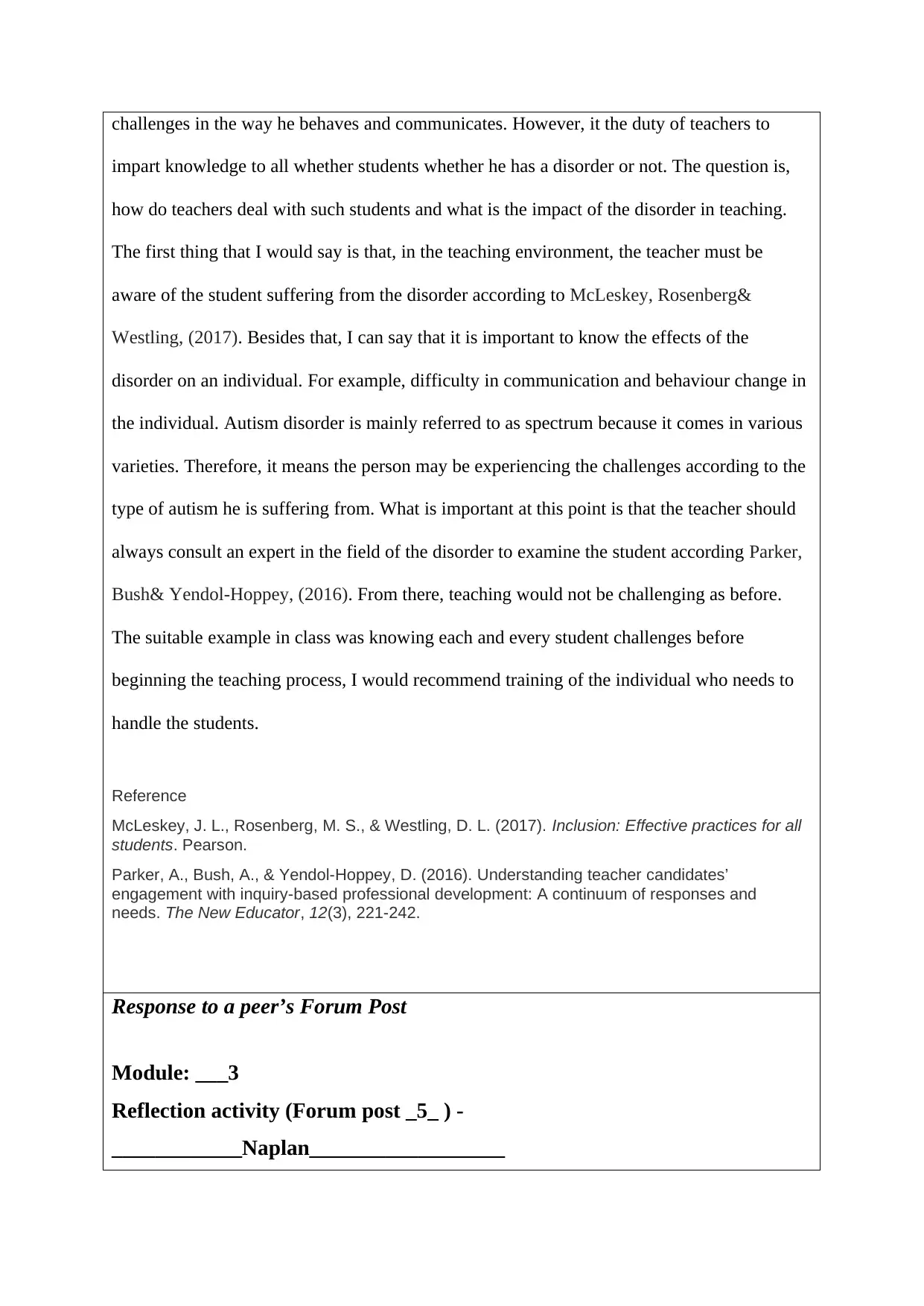
challenges in the way he behaves and communicates. However, it the duty of teachers to
impart knowledge to all whether students whether he has a disorder or not. The question is,
how do teachers deal with such students and what is the impact of the disorder in teaching.
The first thing that I would say is that, in the teaching environment, the teacher must be
aware of the student suffering from the disorder according to McLeskey, Rosenberg&
Westling, (2017). Besides that, I can say that it is important to know the effects of the
disorder on an individual. For example, difficulty in communication and behaviour change in
the individual. Autism disorder is mainly referred to as spectrum because it comes in various
varieties. Therefore, it means the person may be experiencing the challenges according to the
type of autism he is suffering from. What is important at this point is that the teacher should
always consult an expert in the field of the disorder to examine the student according Parker,
Bush& Yendol-Hoppey, (2016). From there, teaching would not be challenging as before.
The suitable example in class was knowing each and every student challenges before
beginning the teaching process, I would recommend training of the individual who needs to
handle the students.
Reference
McLeskey, J. L., Rosenberg, M. S., & Westling, D. L. (2017). Inclusion: Effective practices for all
students. Pearson.
Parker, A., Bush, A., & Yendol-Hoppey, D. (2016). Understanding teacher candidates’
engagement with inquiry-based professional development: A continuum of responses and
needs. The New Educator, 12(3), 221-242.
Response to a peer’s Forum Post
Module: ___3
Reflection activity (Forum post _5_ ) -
____________Naplan__________________
impart knowledge to all whether students whether he has a disorder or not. The question is,
how do teachers deal with such students and what is the impact of the disorder in teaching.
The first thing that I would say is that, in the teaching environment, the teacher must be
aware of the student suffering from the disorder according to McLeskey, Rosenberg&
Westling, (2017). Besides that, I can say that it is important to know the effects of the
disorder on an individual. For example, difficulty in communication and behaviour change in
the individual. Autism disorder is mainly referred to as spectrum because it comes in various
varieties. Therefore, it means the person may be experiencing the challenges according to the
type of autism he is suffering from. What is important at this point is that the teacher should
always consult an expert in the field of the disorder to examine the student according Parker,
Bush& Yendol-Hoppey, (2016). From there, teaching would not be challenging as before.
The suitable example in class was knowing each and every student challenges before
beginning the teaching process, I would recommend training of the individual who needs to
handle the students.
Reference
McLeskey, J. L., Rosenberg, M. S., & Westling, D. L. (2017). Inclusion: Effective practices for all
students. Pearson.
Parker, A., Bush, A., & Yendol-Hoppey, D. (2016). Understanding teacher candidates’
engagement with inquiry-based professional development: A continuum of responses and
needs. The New Educator, 12(3), 221-242.
Response to a peer’s Forum Post
Module: ___3
Reflection activity (Forum post _5_ ) -
____________Naplan__________________
⊘ This is a preview!⊘
Do you want full access?
Subscribe today to unlock all pages.

Trusted by 1+ million students worldwide
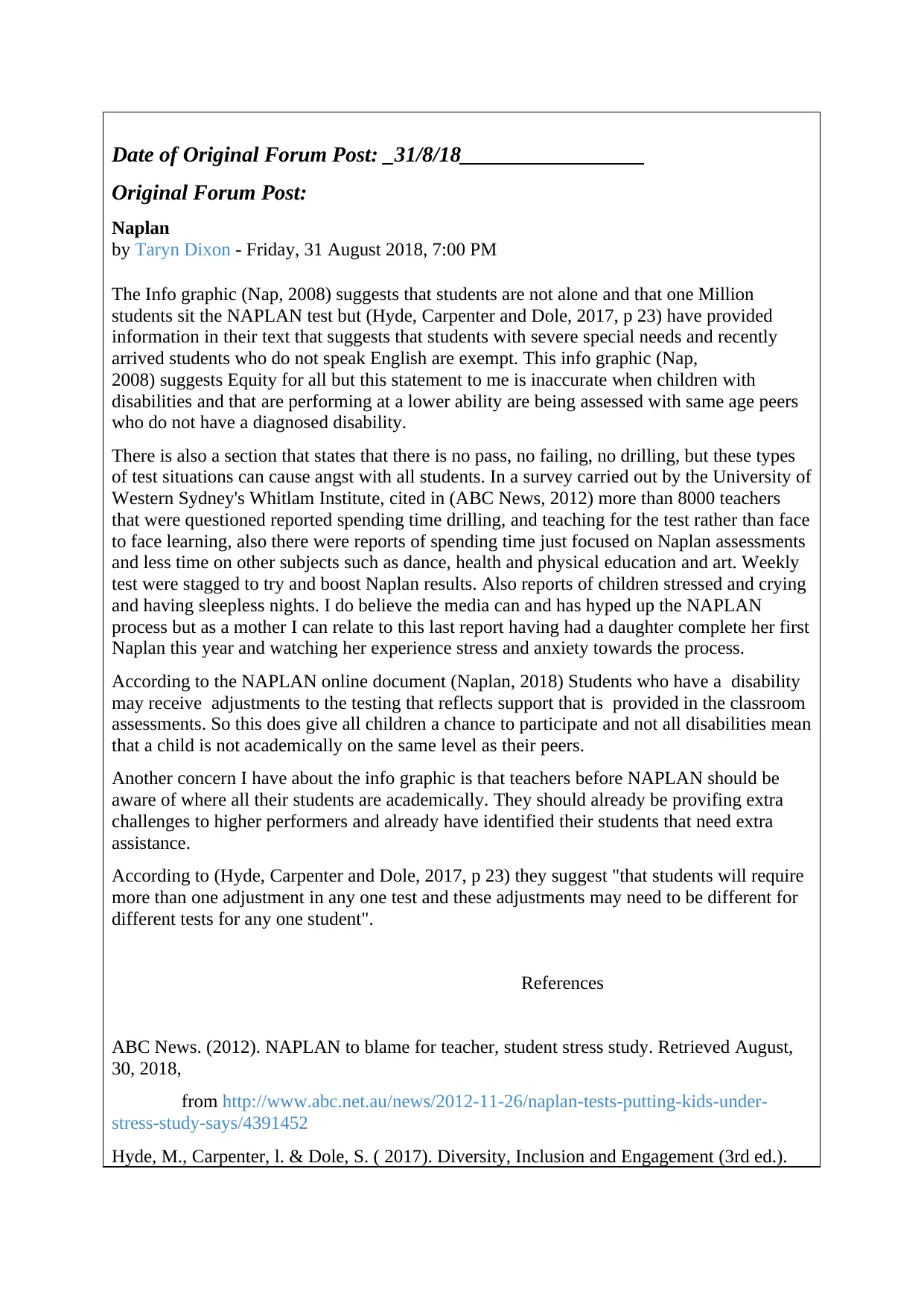
Date of Original Forum Post: _31/8/18_________________
Original Forum Post:
Naplan
by Taryn Dixon - Friday, 31 August 2018, 7:00 PM
The Info graphic (Nap, 2008) suggests that students are not alone and that one Million
students sit the NAPLAN test but (Hyde, Carpenter and Dole, 2017, p 23) have provided
information in their text that suggests that students with severe special needs and recently
arrived students who do not speak English are exempt. This info graphic (Nap,
2008) suggests Equity for all but this statement to me is inaccurate when children with
disabilities and that are performing at a lower ability are being assessed with same age peers
who do not have a diagnosed disability.
There is also a section that states that there is no pass, no failing, no drilling, but these types
of test situations can cause angst with all students. In a survey carried out by the University of
Western Sydney's Whitlam Institute, cited in (ABC News, 2012) more than 8000 teachers
that were questioned reported spending time drilling, and teaching for the test rather than face
to face learning, also there were reports of spending time just focused on Naplan assessments
and less time on other subjects such as dance, health and physical education and art. Weekly
test were stagged to try and boost Naplan results. Also reports of children stressed and crying
and having sleepless nights. I do believe the media can and has hyped up the NAPLAN
process but as a mother I can relate to this last report having had a daughter complete her first
Naplan this year and watching her experience stress and anxiety towards the process.
According to the NAPLAN online document (Naplan, 2018) Students who have a disability
may receive adjustments to the testing that reflects support that is provided in the classroom
assessments. So this does give all children a chance to participate and not all disabilities mean
that a child is not academically on the same level as their peers.
Another concern I have about the info graphic is that teachers before NAPLAN should be
aware of where all their students are academically. They should already be provifing extra
challenges to higher performers and already have identified their students that need extra
assistance.
According to (Hyde, Carpenter and Dole, 2017, p 23) they suggest "that students will require
more than one adjustment in any one test and these adjustments may need to be different for
different tests for any one student".
References
ABC News. (2012). NAPLAN to blame for teacher, student stress study. Retrieved August,
30, 2018,
from http://www.abc.net.au/news/2012-11-26/naplan-tests-putting-kids-under-
stress-study-says/4391452
Hyde, M., Carpenter, l. & Dole, S. ( 2017). Diversity, Inclusion and Engagement (3rd ed.).
Original Forum Post:
Naplan
by Taryn Dixon - Friday, 31 August 2018, 7:00 PM
The Info graphic (Nap, 2008) suggests that students are not alone and that one Million
students sit the NAPLAN test but (Hyde, Carpenter and Dole, 2017, p 23) have provided
information in their text that suggests that students with severe special needs and recently
arrived students who do not speak English are exempt. This info graphic (Nap,
2008) suggests Equity for all but this statement to me is inaccurate when children with
disabilities and that are performing at a lower ability are being assessed with same age peers
who do not have a diagnosed disability.
There is also a section that states that there is no pass, no failing, no drilling, but these types
of test situations can cause angst with all students. In a survey carried out by the University of
Western Sydney's Whitlam Institute, cited in (ABC News, 2012) more than 8000 teachers
that were questioned reported spending time drilling, and teaching for the test rather than face
to face learning, also there were reports of spending time just focused on Naplan assessments
and less time on other subjects such as dance, health and physical education and art. Weekly
test were stagged to try and boost Naplan results. Also reports of children stressed and crying
and having sleepless nights. I do believe the media can and has hyped up the NAPLAN
process but as a mother I can relate to this last report having had a daughter complete her first
Naplan this year and watching her experience stress and anxiety towards the process.
According to the NAPLAN online document (Naplan, 2018) Students who have a disability
may receive adjustments to the testing that reflects support that is provided in the classroom
assessments. So this does give all children a chance to participate and not all disabilities mean
that a child is not academically on the same level as their peers.
Another concern I have about the info graphic is that teachers before NAPLAN should be
aware of where all their students are academically. They should already be provifing extra
challenges to higher performers and already have identified their students that need extra
assistance.
According to (Hyde, Carpenter and Dole, 2017, p 23) they suggest "that students will require
more than one adjustment in any one test and these adjustments may need to be different for
different tests for any one student".
References
ABC News. (2012). NAPLAN to blame for teacher, student stress study. Retrieved August,
30, 2018,
from http://www.abc.net.au/news/2012-11-26/naplan-tests-putting-kids-under-
stress-study-says/4391452
Hyde, M., Carpenter, l. & Dole, S. ( 2017). Diversity, Inclusion and Engagement (3rd ed.).
Paraphrase This Document
Need a fresh take? Get an instant paraphrase of this document with our AI Paraphraser
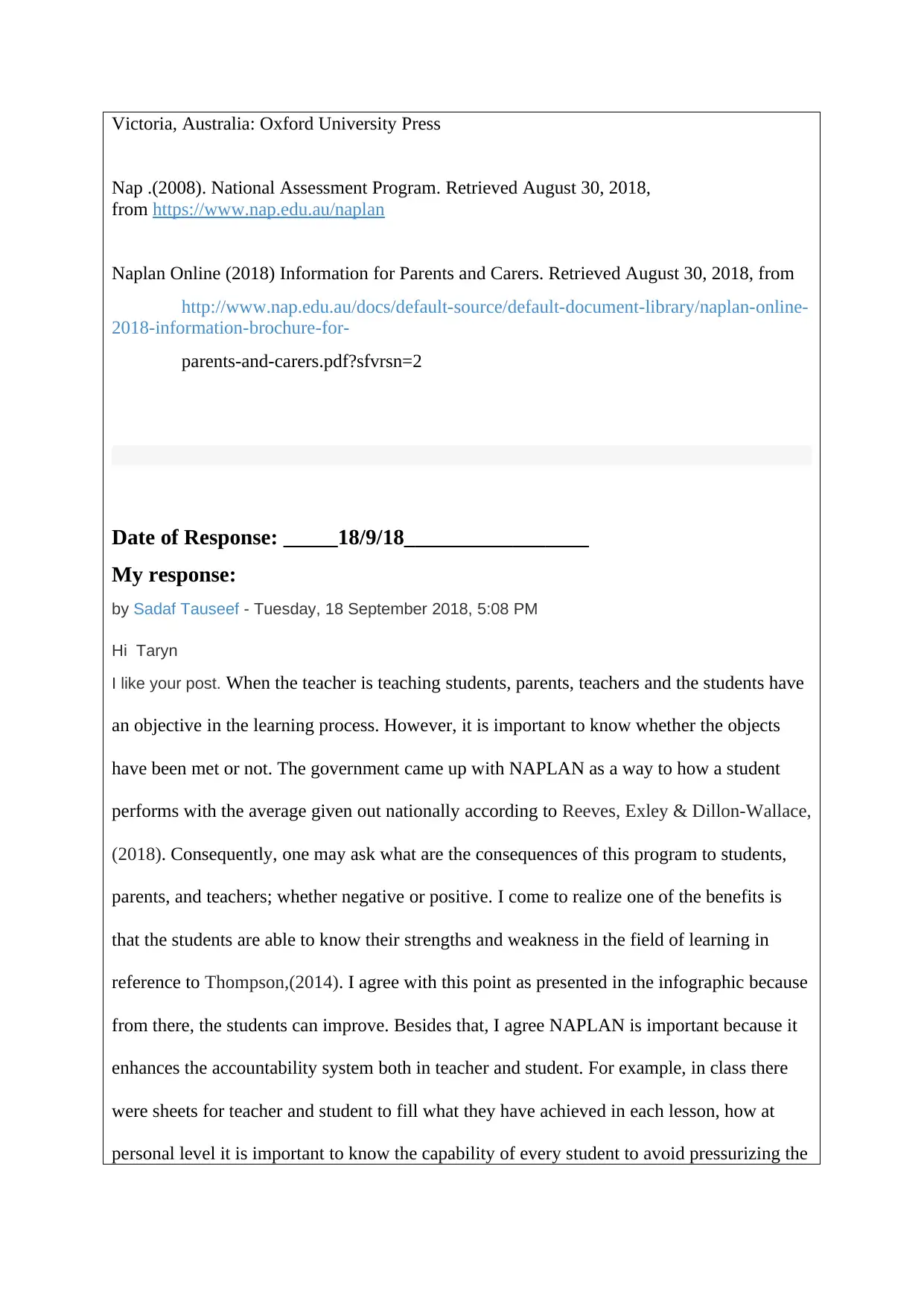
Victoria, Australia: Oxford University Press
Nap .(2008). National Assessment Program. Retrieved August 30, 2018,
from https://www.nap.edu.au/naplan
Naplan Online (2018) Information for Parents and Carers. Retrieved August 30, 2018, from
http://www.nap.edu.au/docs/default-source/default-document-library/naplan-online-
2018-information-brochure-for-
parents-and-carers.pdf?sfvrsn=2
Date of Response: _____18/9/18_________________
My response:
by Sadaf Tauseef - Tuesday, 18 September 2018, 5:08 PM
Hi Taryn
I like your post. When the teacher is teaching students, parents, teachers and the students have
an objective in the learning process. However, it is important to know whether the objects
have been met or not. The government came up with NAPLAN as a way to how a student
performs with the average given out nationally according to Reeves, Exley & Dillon-Wallace,
(2018). Consequently, one may ask what are the consequences of this program to students,
parents, and teachers; whether negative or positive. I come to realize one of the benefits is
that the students are able to know their strengths and weakness in the field of learning in
reference to Thompson,(2014). I agree with this point as presented in the infographic because
from there, the students can improve. Besides that, I agree NAPLAN is important because it
enhances the accountability system both in teacher and student. For example, in class there
were sheets for teacher and student to fill what they have achieved in each lesson, how at
personal level it is important to know the capability of every student to avoid pressurizing the
Nap .(2008). National Assessment Program. Retrieved August 30, 2018,
from https://www.nap.edu.au/naplan
Naplan Online (2018) Information for Parents and Carers. Retrieved August 30, 2018, from
http://www.nap.edu.au/docs/default-source/default-document-library/naplan-online-
2018-information-brochure-for-
parents-and-carers.pdf?sfvrsn=2
Date of Response: _____18/9/18_________________
My response:
by Sadaf Tauseef - Tuesday, 18 September 2018, 5:08 PM
Hi Taryn
I like your post. When the teacher is teaching students, parents, teachers and the students have
an objective in the learning process. However, it is important to know whether the objects
have been met or not. The government came up with NAPLAN as a way to how a student
performs with the average given out nationally according to Reeves, Exley & Dillon-Wallace,
(2018). Consequently, one may ask what are the consequences of this program to students,
parents, and teachers; whether negative or positive. I come to realize one of the benefits is
that the students are able to know their strengths and weakness in the field of learning in
reference to Thompson,(2014). I agree with this point as presented in the infographic because
from there, the students can improve. Besides that, I agree NAPLAN is important because it
enhances the accountability system both in teacher and student. For example, in class there
were sheets for teacher and student to fill what they have achieved in each lesson, how at
personal level it is important to know the capability of every student to avoid pressurizing the
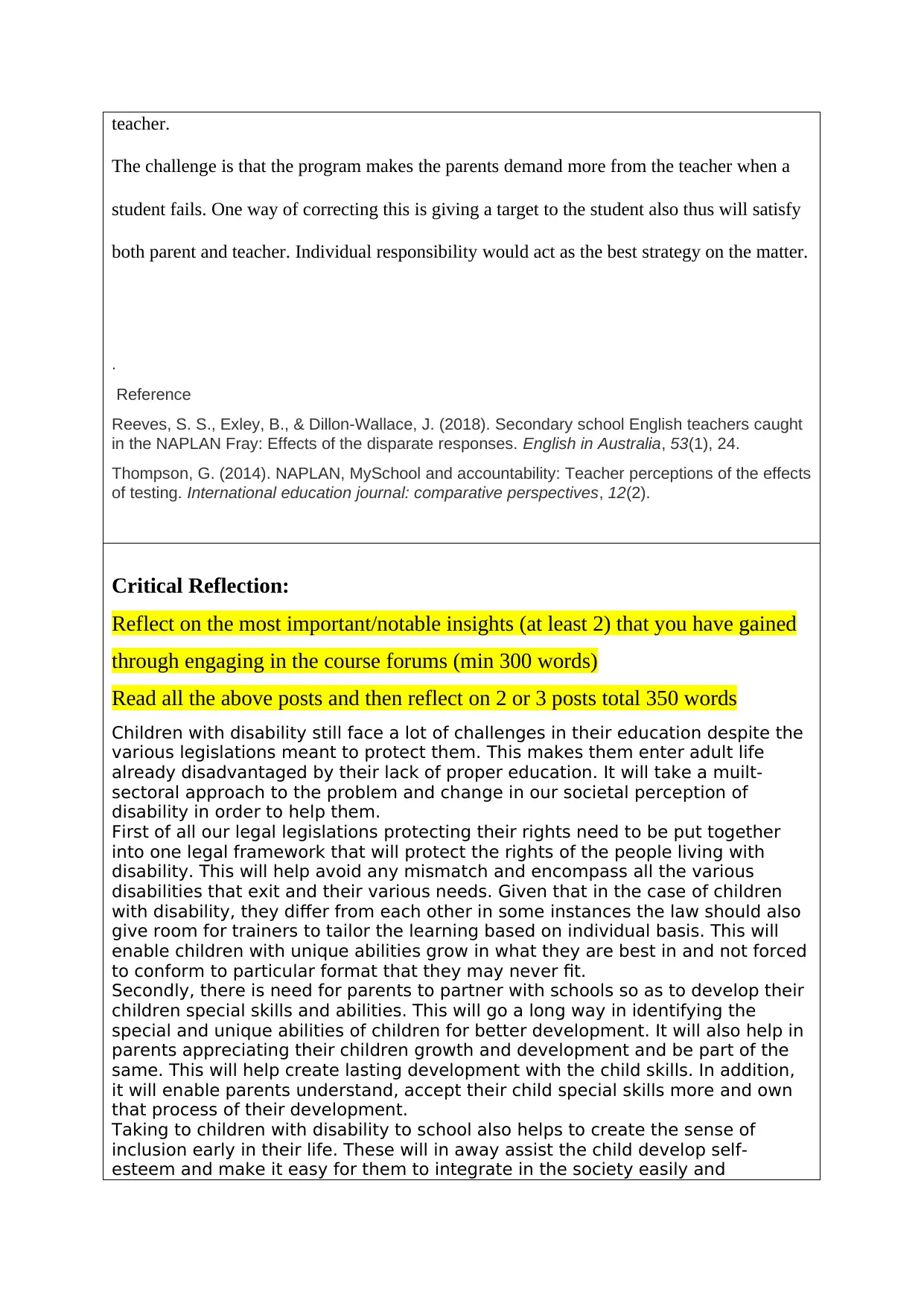
teacher.
The challenge is that the program makes the parents demand more from the teacher when a
student fails. One way of correcting this is giving a target to the student also thus will satisfy
both parent and teacher. Individual responsibility would act as the best strategy on the matter.
.
Reference
Reeves, S. S., Exley, B., & Dillon-Wallace, J. (2018). Secondary school English teachers caught
in the NAPLAN Fray: Effects of the disparate responses. English in Australia, 53(1), 24.
Thompson, G. (2014). NAPLAN, MySchool and accountability: Teacher perceptions of the effects
of testing. International education journal: comparative perspectives, 12(2).
Critical Reflection:
Reflect on the most important/notable insights (at least 2) that you have gained
through engaging in the course forums (min 300 words)
Read all the above posts and then reflect on 2 or 3 posts total 350 words
Children with disability still face a lot of challenges in their education despite the
various legislations meant to protect them. This makes them enter adult life
already disadvantaged by their lack of proper education. It will take a muilt-
sectoral approach to the problem and change in our societal perception of
disability in order to help them.
First of all our legal legislations protecting their rights need to be put together
into one legal framework that will protect the rights of the people living with
disability. This will help avoid any mismatch and encompass all the various
disabilities that exit and their various needs. Given that in the case of children
with disability, they differ from each other in some instances the law should also
give room for trainers to tailor the learning based on individual basis. This will
enable children with unique abilities grow in what they are best in and not forced
to conform to particular format that they may never fit.
Secondly, there is need for parents to partner with schools so as to develop their
children special skills and abilities. This will go a long way in identifying the
special and unique abilities of children for better development. It will also help in
parents appreciating their children growth and development and be part of the
same. This will help create lasting development with the child skills. In addition,
it will enable parents understand, accept their child special skills more and own
that process of their development.
Taking to children with disability to school also helps to create the sense of
inclusion early in their life. These will in away assist the child develop self-
esteem and make it easy for them to integrate in the society easily and
The challenge is that the program makes the parents demand more from the teacher when a
student fails. One way of correcting this is giving a target to the student also thus will satisfy
both parent and teacher. Individual responsibility would act as the best strategy on the matter.
.
Reference
Reeves, S. S., Exley, B., & Dillon-Wallace, J. (2018). Secondary school English teachers caught
in the NAPLAN Fray: Effects of the disparate responses. English in Australia, 53(1), 24.
Thompson, G. (2014). NAPLAN, MySchool and accountability: Teacher perceptions of the effects
of testing. International education journal: comparative perspectives, 12(2).
Critical Reflection:
Reflect on the most important/notable insights (at least 2) that you have gained
through engaging in the course forums (min 300 words)
Read all the above posts and then reflect on 2 or 3 posts total 350 words
Children with disability still face a lot of challenges in their education despite the
various legislations meant to protect them. This makes them enter adult life
already disadvantaged by their lack of proper education. It will take a muilt-
sectoral approach to the problem and change in our societal perception of
disability in order to help them.
First of all our legal legislations protecting their rights need to be put together
into one legal framework that will protect the rights of the people living with
disability. This will help avoid any mismatch and encompass all the various
disabilities that exit and their various needs. Given that in the case of children
with disability, they differ from each other in some instances the law should also
give room for trainers to tailor the learning based on individual basis. This will
enable children with unique abilities grow in what they are best in and not forced
to conform to particular format that they may never fit.
Secondly, there is need for parents to partner with schools so as to develop their
children special skills and abilities. This will go a long way in identifying the
special and unique abilities of children for better development. It will also help in
parents appreciating their children growth and development and be part of the
same. This will help create lasting development with the child skills. In addition,
it will enable parents understand, accept their child special skills more and own
that process of their development.
Taking to children with disability to school also helps to create the sense of
inclusion early in their life. These will in away assist the child develop self-
esteem and make it easy for them to integrate in the society easily and
⊘ This is a preview!⊘
Do you want full access?
Subscribe today to unlock all pages.

Trusted by 1+ million students worldwide
1 out of 13
Related Documents
Your All-in-One AI-Powered Toolkit for Academic Success.
+13062052269
info@desklib.com
Available 24*7 on WhatsApp / Email
![[object Object]](/_next/static/media/star-bottom.7253800d.svg)
Unlock your academic potential
Copyright © 2020–2025 A2Z Services. All Rights Reserved. Developed and managed by ZUCOL.




